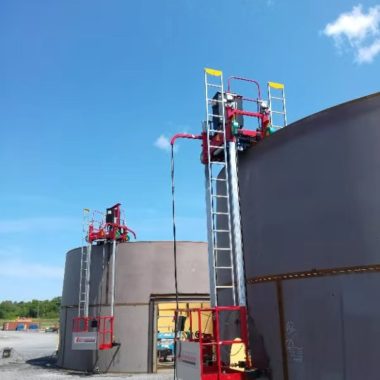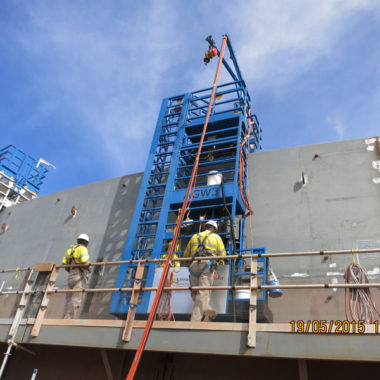Professional Container Welding Evaluation Solutions for Quality Assurance and Conformity
Professional storage tank welding examination remedies stand as the cornerstone of quality control and compliance actions embraced by industries. From meticulous assessments to innovative strategies, the realm of tank welding examination supplies a sophisticated landscape of practices aimed at supporting requirements and mitigating threats.
Significance of Storage Tank Welding Examination
Guaranteeing the quality of tank welding through thorough examination is essential in preserving architectural stability and stopping potential dangers in industrial settings. Storage tank welding plays a crucial duty in various industries, consisting of oil and manufacturing, chemical, and gas handling. The structural integrity of tanks is critical to stop leaks, spills, and various other dangerous incidents that can lead to environmental damages, economic losses, and also threaten lives.
With strenuous examination procedures, welding defects such as cracks, incomplete blend, and porosity can be recognized and rectified promptly. Examinations additionally help guarantee compliance with industry criteria and guidelines, offering a level of assurance relating to the high quality and safety of the bonded containers.
Normal examinations not only improve the general high quality of container welding yet also add to the long life and reliability of industrial equipment. By detecting and resolving concerns beforehand, companies can avoid pricey repair work, downtime, and prospective mishaps, eventually securing their procedures and track record.
Advanced Examination Methods
One sophisticated strategy that has reinvented storage tank welding assessment is the usage of automated ultrasonic testing (AUT) This approach gets rid of human mistake and guarantees thorough protection of welds, improving the overall quality of examinations.
Furthermore, phased selection ultrasonic screening (PAUT) is one more sophisticated evaluation method acquiring popularity in tank welding examinations. Tank Welding Inspection Service. PAUT permits precise control over the ultrasonic beam angle and focal factor, allowing examiners to detect and define flaws with high resolution. This method is specifically reliable in examining complex geometries and can offer comprehensive imaging of weld problems for extensive evaluation
In enhancement to AUT and PAUT, progressed radiographic screening approaches, such as digital radiography, are being progressively utilized in tank welding examinations. These techniques offer enhanced picture high quality, lowered examination times, and boosted security contrasted to typical radiographic techniques. By including these sophisticated evaluation techniques, industries can ensure better control and conformity with governing standards in container welding processes.
Educated Inspection Professionals
Effectiveness in examination techniques is extremely important for making certain the accuracy and reliability of tank welding evaluations in industrial setups. Trained examination specialists play a critical duty in maintaining quality assurance requirements and making certain conformity with governing needs. These specialists go through rigorous training to establish competence in numerous evaluation methods, consisting of aesthetic screening, ultrasonic testing, radiographic screening, and magnetic particle screening.
Certified evaluation experts are well-versed in interpreting codes and standards details to tank welding, such as API 653 and API 650. They have original site the expertise and abilities to determine welding problems, evaluate weld quality, and make informed decisions regarding the reputation of bonded joints. In addition, these professionals are educated to run innovative inspection equipment and use specialized tools to carry out thorough examinations of container welds.
Cost-efficient Quality Control Solutions

Among the challenges of maintaining high standards in tank welding inspections, the quest for cost-effective quality control solutions arises as a pivotal focus for industrial procedures. One cost-efficient service is the utilization of advanced assessment technologies such as automated welding examination systems.
Along with technological innovations, establishing a comprehensive quality control plan that consists of routine evaluations, paperwork, and staff member training can considerably add to set you back financial savings in the long-term. By investing in training programs for welding examiners and ensuring adherence to sector requirements, business can proactively recognize concerns, minimize rework, and avoid expensive repairs.
Additionally, contracting out specialized assessment solutions when required can be an affordable method for companies that do not have the expertise or you can find out more resources in-house. find out here now Teaming up with credible evaluation firms can provide access to proficient professionals and innovative tools without the requirement for considerable capital expense. Eventually, focusing on economical high quality control options is crucial for achieving functional efficiency, meeting regulatory demands, and delivering high-grade bonded tanks.
Ensuring Regulatory Conformity


Regulative conformity in container welding evaluations is a fundamental element of making certain market requirements and security demands are satisfied. Abiding by regulatory guidelines stated by organizations such as the American Petroleum Institute (API) and Occupational Safety And Security and Health Administration (OSHA) is critical to guaranteeing the stability and integrity of bonded containers. These policies lay out particular requirements for welding treatments, material specifications, examination techniques, and quality assurance measures that need to be followed to preserve operational excellence and prevent possible hazards.
To ensure regulative conformity in tank welding evaluations, qualified welding examiners should possess a comprehensive understanding of the suitable codes and standards. Regular audits and analyses ought to be performed to confirm that welding procedures and procedures straighten with regulative demands. Additionally, paperwork and record-keeping are crucial parts of conformity, offering a clear route of adherence to regulations for auditing purposes.
Verdict
To conclude, professional storage tank welding examination remedies play a vital duty in guaranteeing the top quality control and conformity of storage tanks. By utilizing sophisticated examination methods and trained specialists, firms can properly check the welding process, identify prospective problems, and keep regulatory conformity (Tank Welding Inspection Service). This positive method not just helps in preventing costly repair work and downtime but additionally makes certain the safety and honesty of the tanks
From careful assessments to innovative techniques, the realm of storage tank welding examination uses a sophisticated landscape of practices aimed at supporting standards and mitigating risks.Moreover, phased selection ultrasonic screening (PAUT) is one more sophisticated examination method acquiring popularity in tank welding evaluations.Proficiency in evaluation strategies is paramount for making certain the accuracy and reliability of storage tank welding evaluations in industrial settings. One affordable service is the application of advanced evaluation technologies such as automated welding examination systems.In final thought, professional storage tank welding inspection services play a crucial function in making sure the top quality control and compliance of containers.


